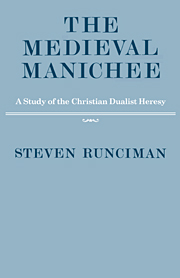Book contents
- Frontmatter
- Contents
- CHAPTER I Introduction
- CHAPTER II The Gnostic Background
- CHAPTER III The Paulicians
- CHAPTER IV The Bogomils
- CHAPTER V The Patarenes
- CHAPTER VI The Cathars
- CHAPTER VII The Dualist Tradition
- APPENDIX I The Greek Sources for Paulician history
- APPENDIX II Heretical Movements in the Eighth Century
- APPENDIX III Various Names given to the Dualist Heretics in Europe
- APPENDIX IV Dualism, Buddhism and Occultism
- BIBLIOGRAPHY
- ADDITIONS (1982)
- INDEX
APPENDIX II - Heretical Movements in the Eighth Century
- Frontmatter
- Contents
- CHAPTER I Introduction
- CHAPTER II The Gnostic Background
- CHAPTER III The Paulicians
- CHAPTER IV The Bogomils
- CHAPTER V The Patarenes
- CHAPTER VI The Cathars
- CHAPTER VII The Dualist Tradition
- APPENDIX I The Greek Sources for Paulician history
- APPENDIX II Heretical Movements in the Eighth Century
- APPENDIX III Various Names given to the Dualist Heretics in Europe
- APPENDIX IV Dualism, Buddhism and Occultism
- BIBLIOGRAPHY
- ADDITIONS (1982)
- INDEX
Summary
The Byzantine Empire under the Iconoclastic Emperors was undoubtedly a favourable soil for the spread of Puritanistic heresies. But it would be a mistake to assume that therefore Iconoclasm and the Puritan heresies of the time belonged to the same tradition. There were, I think, five distinct and separate movements.
(i) Iconoclasm. This was largely political in origin; it was a movement started within the Church against certain sections of the Church, namely, the monastic vested interests. Theologically it was a Christological heresy. It taught that Christ the God could not be depicted, and therefore pictures of Christ could only show Jesus the man and so were not suitable objects for worship. Similarly, pictures of the Saints could only show their earthly forms and not the Divine spirit that had made them Saints. This theology is somewhat unsound, savouring of Monophysitism; and in the controversy the Iconodule theologians certainly put forward the better case. But Iconoclasm was formidable because of its political background—because of a general jealousy of the monasteries, who championed Image-worship and found it financially profitable, and because of the tendency of the Semitic elements in the Empire to favour a greater simplicity of worship and to take seriously the old Mosaic injunction against graven images. The contemporaneous growth of Islam is another example of this sentiment. But theologically Iconoclasm did not belong to the Gnostic Tradition, and politically it was what we should now call Erastian. It believed in a State Church.
[…]
- Type
- Chapter
- Information
- The Medieval ManicheeA Study of the Christian Dualist Heresy, pp. 182 - 183Publisher: Cambridge University PressPrint publication year: 1982



